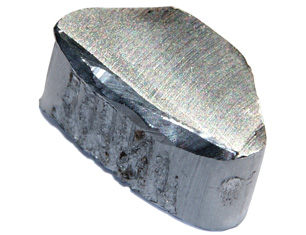Aluminum
| EPA Maximum Contaminant Level Goal (MCLG) |
0.05 to 0.2 mg/L |

Aluminum is an abundant metal in nature, but it does not dissolve easily in water and is typically not a drinking water concern. The main source of human exposure to aluminum is through food.
Natural water can contain from 0.1 to as much as 9.0 parts per million aluminum, but by far the most common source of aluminum in drinking water is alum (aluminum sulfate) that is added by water treatment plants to aid in clarification. (Alum causes tiny particles to clump together, making them more easily filterable.)
Health Effects of Aluminum
According to the World Health Organization, aluminum is common and harmless with acute exposure:
There is little indication that aluminium is acutely toxic by oral exposure despite its widespread occurrence in foods, drinking-water, and many antacid preparations.
There is a possible connection between aluminum and diseases that affect the nervous system, especially Alzheimer's disease.
Water Treatment for Aluminum
Aluminum can be removed by a cation exchanger (water softener) but this is not regarded as a practical home treatment because regeneration of the exchange bed must be done with sulfuric or hydrochloric acid.
Home treatment of drinking water can be accomplished with reverse osmosis or distillation, removing 98% or more. There is the possibility, however, under the right pH conditions, that aluminum can be a foulant to reverse osmosis membranes.
Aluminum is also removed by electrodialysis, and claims are made by manufacturers of KDF/Carbon filters that KDF removes aluminum, but we can find no evidence to support this.
Sources: WHO, Photo: images-of-elements.com
Site Index
Filtration Systems
- Aeration for Iron & Sulfide
- Backwashing Filters
(whole house & well units)
- Chlorine & Chemical Injectors
- Countertop Water Filters
- Emergency Filters
- Garden Hose Filters
- Reverse Osmosis, Residential
- Reverse Osmosis, Commercial
- Shower Filters
- Specialty Filters
- Ultraviolet Systems
- Undersink Filters
- Water Softeners
- Whole House Filters
Cartridges
Parts
- Replacement Parts
- Faucets
- Filter Media
- Fittings
- Housings
- O-rings
- Pumps
- Pura UV
- R.O. Parts
- R.O. Tanks
- R.O. Booster Pump
- VIQUA UV